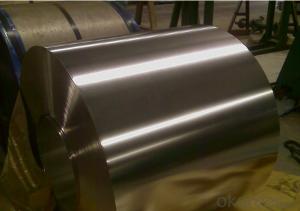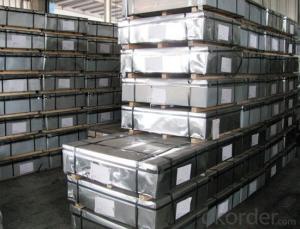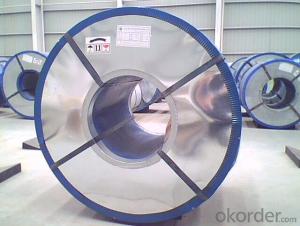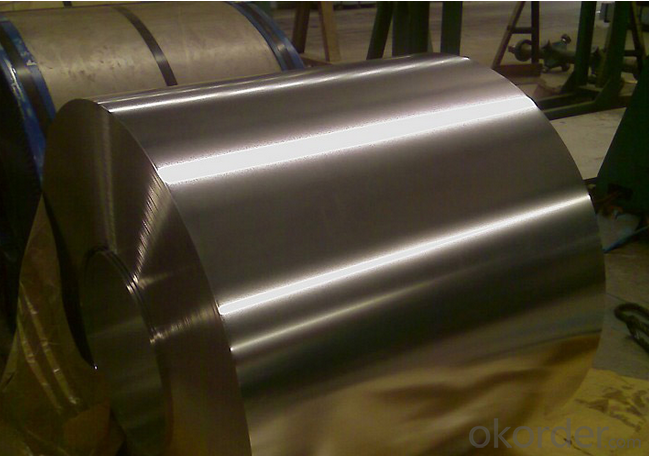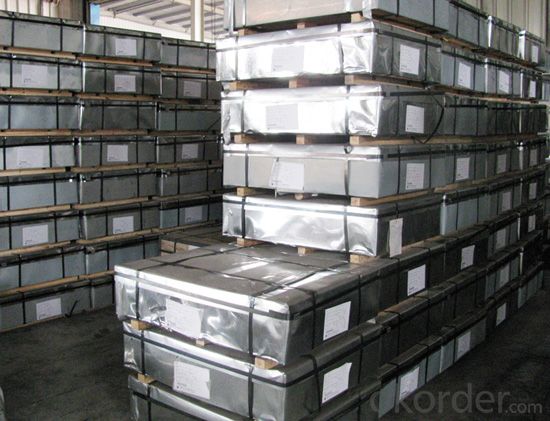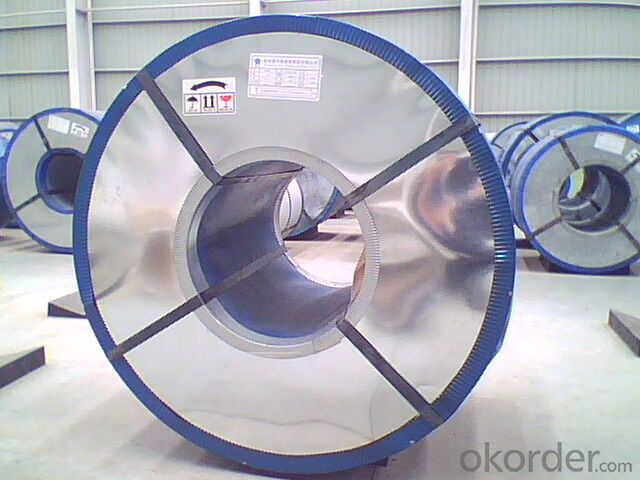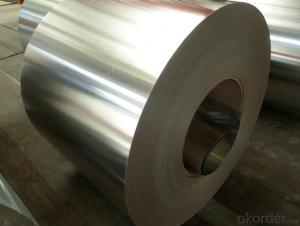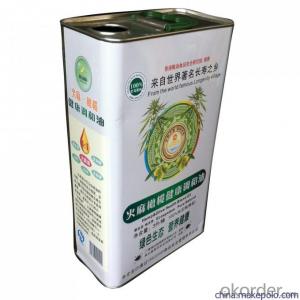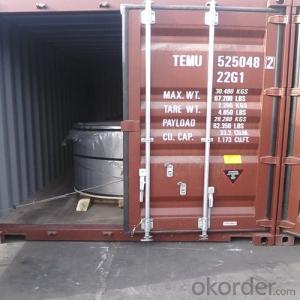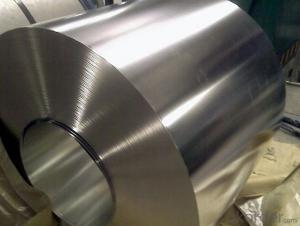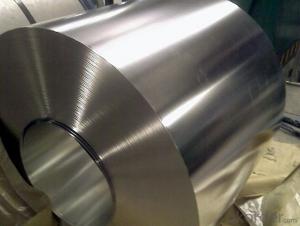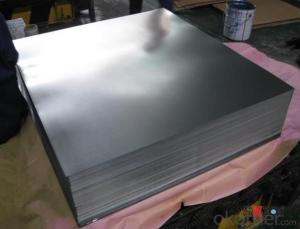Electrolytic Tinplate (ETP) Coil and Sheets for Foods and Chemical Packaging
- Loading Port:
- Tianjin
- Payment Terms:
- TT OR LC
- Min Order Qty:
- 25 m.t.
- Supply Capability:
- 7000 m.t./month
OKorder Service Pledge
OKorder Financial Service
You Might Also Like
1.Structure of Electrolytic Tinplate (ETP) Coil and Sheets for Foods and Chemical Packaging Description
Electrolytic Tin Plate Coils and Sheets for Foods Metal Packaging, is one thin steel sheet with a coating of tin applied by electrolytic deposition. Tinplate made by this process is essentially a sandwich in which the central core is strip steel. This core is cleaned in a pickling solution and then fed through tanks containing electrolyte, where tin is deposited on both sides. As the strip passes between high-frequency electric induction coils, it is heated so that the tin coating melts and flows to form a lustrous coat.
2.Main Features of the Electrolytic Tinplate (ETP) Coil and Sheets for Foods and Chemical Packaging
Appearance – Electrolytic Tin Plate is characterized by its beautiful metallic luster. Products with various kinds of surface roughness are produced by selecting the surface finish of the substrate steel sheet.
Paintability and printability – Electrolytic Tin Plates have excellent paintability and printability. Printing is beautifully finished using various lacquers and inks.
Formability and strength – Electrolytic Tin Plates have got very good formability and strength. By selecting a proper temper grade, appropriate formability is obtained for different applications as well as the required strength after forming.
Corrosion resistance – Tinplate has got good corrosion resistance. By selecting a proper coating weight, appropriate corrosion resistance is obtained against container contents. Coated items should meet 24 hour 5 % salt spray requirement.
Solderability and weldability – Electrolytic Tin Plates can be joined both by soldering or welding. These properties of tinplate are used for making various types of cans.
Hygienic – Tin coating provides good and non toxic barrier properties to protect food products from impurities, bacteria, moisture, light and odours.
Safe – Tinplate being low weight and high strength makes food cans easy to ship and transport.
Eco friendly – Tinplate offers 100 % recyclability.
Tin is not good for low temperature applications since it changes structure and loses adhesion when exposed to temperatures below – 40 deg C.
3.Electrolytic Tinplate (ETP) Coil and Sheets for Foods and Chemical Packaging Images
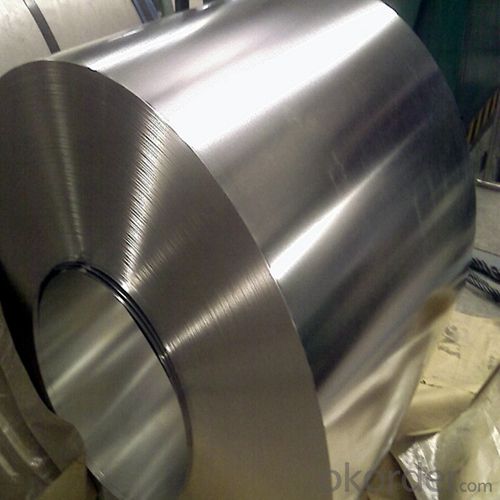

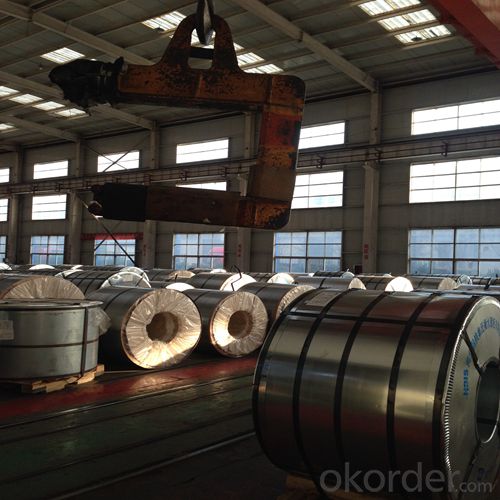
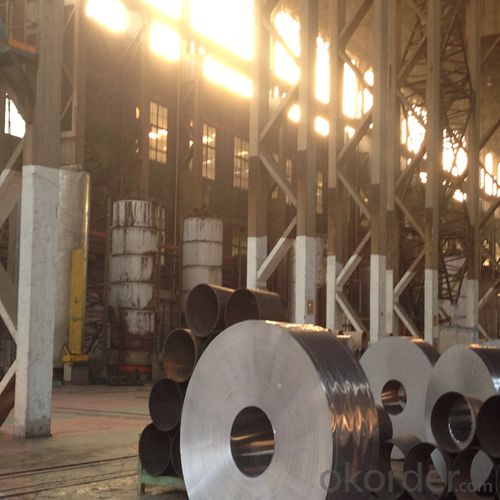
4.Electrolytic Tinplate (ETP) Coil and Sheets for Foods and Chemical Packaging Specification
Standard | ISO 11949 -1995, GB/T2520-2000,JIS G3303,ASTM A623, BS EN 10202
|
Material | MR,SPCC |
Thickness | 0.15mm - 0.50mm |
Width | 600mm -1150mm |
Temper | T1-T5 |
Annealing | BA & CA |
Coil Inner Diameter | 508mm |
Weight | 6-10 tons/coil 1~1.7 tons/sheets bundle |
Passivation | 311 |
Oil | DOS |
Surface | Finish,bright,stone,matte,silver |
5.FAQ of Electrolytic Tinplate (ETP) Coil and Sheets for Foods and Chemical Packaging
- How are the Electrolytic Tin Plates specified?
The Electrolytic Tin Plates are specified as per the steel base, extent of tempering, the coating weight, annealing method and the surface finish.
- How many types there are for base steels?
The base steels are of three types: Type MR, L, D
- How many types there are for base steels?
The base steels are of three types: Type MR, L, D
- Q: What are the benefits of using tinplate for paint cans?
- Tinplate offers numerous benefits for paint cans, including its excellent durability, resistance to corrosion, and ability to maintain product quality by providing a protective barrier. Additionally, tinplate is recyclable, making it a sustainable choice for packaging.
- Q: Soup with tin cans loaded also need high temperature sterilization?
- At present, there are DN400x500, DN600x1000, DN800*1000, DN900*1000 and DN900x1500 in the market, and the small sterilization pot with boilers is heated by steam. If not, heating by electricity can also be done. The phone won't be left. If you need any service from the manufacturer, you can call me from Hi. The key is not to sell, eliminating confusion is the key.
- Q: Can tinplate be used for packaging hazardous materials?
- Yes, tinplate can be used for packaging hazardous materials. Tinplate is a type of steel coated with a thin layer of tin, providing excellent resistance against corrosion and creating a protective barrier. This makes it suitable for containing and transporting hazardous materials safely, as it helps prevent leaks or contamination. Additionally, tinplate is also recyclable, making it an environmentally friendly choice for packaging hazardous substances.
- Q: What are the different types of tinplate welding techniques?
- There are primarily two types of tinplate welding techniques: spot welding and seam welding. Spot welding involves the use of electrical resistance to join two tinplate sheets at specific points, while seam welding is a continuous process that creates a continuous weld along the length of the tinplate sheets.
- Q: What is the average lifespan of tinplate packaging?
- The average lifespan of tinplate packaging can vary depending on various factors such as the storage conditions, usage patterns, and level of care. However, with proper maintenance and handling, tinplate packaging can typically last for several years or even longer.
- Q: How does tinplate contribute to the preservation of tobacco products?
- Tinplate contributes to the preservation of tobacco products by providing a durable and airtight packaging solution. The tin coating on the steel sheet prevents the tobacco from exposure to moisture, light, and oxygen, which can degrade its quality. Additionally, tinplate offers protection against physical damage, ensuring that the tobacco remains intact and fresh for an extended period of time.
- Q: What's the head iron?
- The name "tinplate", also known as tin plated iron, is the common name for tin plated steel sheet. The English abbreviation for "SPTE" refers to cold-rolled low carbon steel sheet or strip coated with commercially pure tin on both sides. Tin plays a major role in preventing corrosion and rusting. It will be the steel strength and formability and corrosion resistance of tin soldering, and beautiful appearance with a material, corrosion resistant, non-toxic, high strength and good ductility properties.
- Q: How is tinplate coated for pharmaceutical packaging?
- Tinplate is commonly coated for pharmaceutical packaging through a process called electrolytic tin coating.
- Q: What are the main applications of tinplate in the pet food industry?
- Tinplate is commonly used in the pet food industry for packaging purposes. It provides a durable and protective barrier against moisture, oxygen, and light, ensuring the quality and freshness of pet food products. The main applications of tinplate in the pet food industry are for manufacturing cans, can lids, and easy-open ends, which help in preserving the nutritional value and extending the shelf life of pet food.
- Q: What are the benefits of using tinplate for coins?
- Tinplate offers several benefits when used for coins. Firstly, tinplate is highly durable, making it resistant to corrosion and wear, ensuring the longevity of the coins. Additionally, tinplate is easily moldable, allowing for intricate designs and detailed engravings on the coin's surface. Moreover, tinplate is a cost-effective material, making it an affordable choice for coin production. Lastly, tinplate is also lightweight, making it convenient for handling and transportation.
Send your message to us
Electrolytic Tinplate (ETP) Coil and Sheets for Foods and Chemical Packaging
- Loading Port:
- Tianjin
- Payment Terms:
- TT OR LC
- Min Order Qty:
- 25 m.t.
- Supply Capability:
- 7000 m.t./month
OKorder Service Pledge
OKorder Financial Service
Similar products
Hot products
Hot Searches
Related keywords
